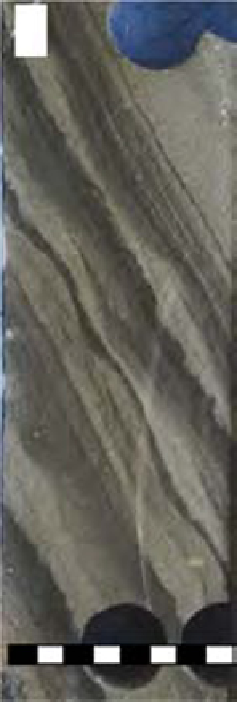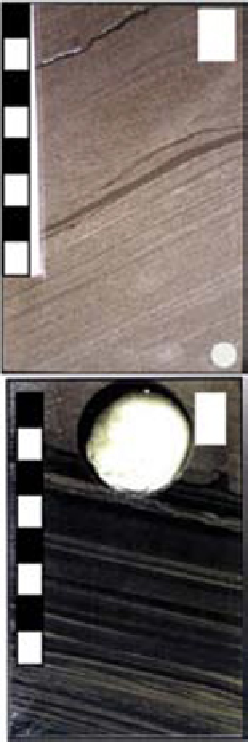Geoscience Reference
In-Depth Information
(B)
(C)
(A)
(D)
8cm
c
c
c
(E)
8cm
8cm
8cm
8cm
Fig. 7.
Comparative examples of shoreface sandstone and turbidite sandstone from the Upper Jurassic of the UK Central
North Sea: (A) Facies S3: bioturbated fine grained sandstone, 22/30b-15Z, 5710.7 mRKB; (B) Facies T4: planar laminated
sandstone, 22/30b-15Z, 5652.8 m RKB; (C) Facies T3: fine grained sandstone and mudstone heterolithic couplets, 30/16A-
31, 4006.4 mRKB; (D) Facies T4: fine grained sandstone displaying both planar stratification and climbing ripple cross-
lamination (marked 'c'), Franklin Sands, 29/4d-4, 5700.85 mRKB; (E) Facies T2: pin-striped micaceous siltstone developed
below a massive fine grained sandstone unit exhibiting loading at the base, 22/30b-11, 5017.8 mRKB.
Model 2 shorefaces are characterised by intense
bioturbation of the lower shoreface and adjacent
shelf. Model 3 shelves display no clear evidence
of shoreline connection and exhibit abundant sili-
ceous sponge spicules together with other open
marine indicators such as belemnites and rare
ammonites. The bulk of deposition is considered
to have occurred in water depths of less than 20 m.
of turbidite development was first mentioned by
Johnson
et al
. (1986) in relation to deposition of
the Kimmeridgian Ribble Sandstone Member of
the Fulmar Field for which there exists an exten-
sive well and core database. Several studies
(Robinson, 1990; Clelland
et al
., 1993; Kuhn
et al
.,
2003) have documented the sedimentology and
stratigraphy of the Ribble Member based on exten-
sive well and core data. Robinson (1990) made a
detailed study and described five turbidite facies
types, here referred to as T1 to T5:
Facies T1: Fissile laminated, non-bioturbated
mudrocks - consisting of uniform, dark grey to
black laminated mudrocks (Fig. 7F) containing
carbonaceous material, pyrite and macrofossils
(ammonites and bivalves). A high gamma ray
Turbidite depositional model
Turbidite facies are considered by this study to
have special significance for understanding Upper
Jurassic depositional history in the Central Graben
due to: (1) their relative rarity and (2) their poorly
understood mechanism of genesis. The possibility




Search WWH ::

Custom Search